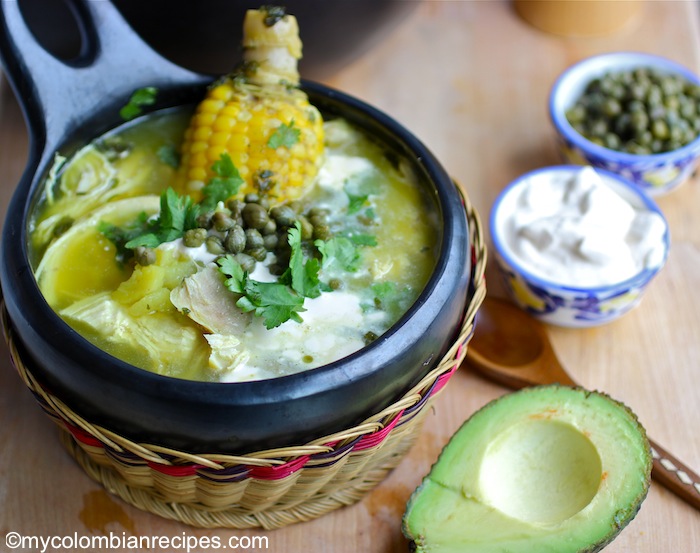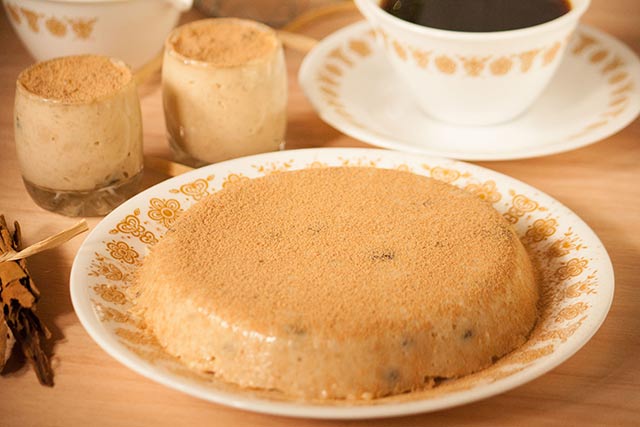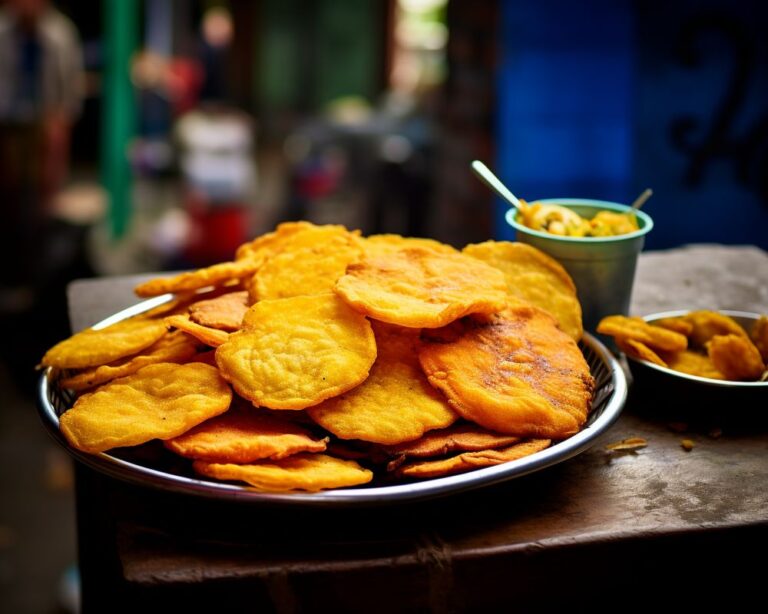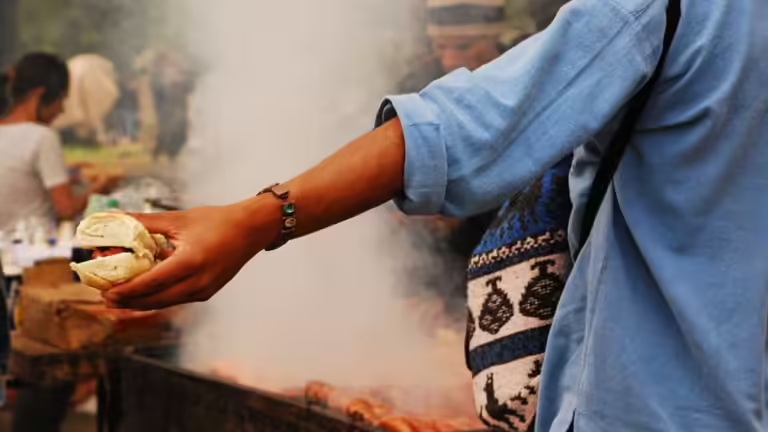Discover the heart and soul of Colombian Christmas through its traditional cuisine. Colombia, a country with a rich cultural heritage, offers a unique and flavorful culinary experience during the holiday season.
In this article, we will explore the Colombian traditional Christmas food that Colombians savor during Christmas, delve into the customs that make Colombian Christmas so special, highlight festive foods, share what Colombians drink on Christmas Eve, and provide five tantalizing recipes to bring the taste of a Colombian Christmas to your home.
The Quintessential Colombian traditional Christmas food
- Ajiaco: A comforting, hearty soup that is a staple in Bogotá. Made with chicken, three types of potatoes, and the Galinsoga parviflora herb, ajiaco is traditionally served with capers, cream, and avocado on the side.
- Lechona: This festive dish consists of a whole pig stuffed with rice, peas, and spices, slow-cooked for hours until the skin is crispy. It’s a showstopper at any Colombian Christmas gathering.
- Tamales: Similar yet distinct from their Mexican cousins, Colombian tamales are wrapped in banana leaves and filled with a mixture of meat, rice, vegetables, and spices.
- Natilla: A sweet custard-like dessert made with milk, panela (unrefined cane sugar), and cinnamon. It’s often enjoyed alongside buñuelos, fried dough balls dusted with sugar.
Christmas in Colombia is not just a celebration; it’s an immersive experience that extends to the dining table. The traditional dishes served during this time are a testament to Colombia’s diverse culinary landscape.
Colombian Christmas Traditions: More than Just Food
The essence of a Colombian Christmas extends beyond the table. The Novena de Aguinaldos, a nine-day series of prayers leading up to Christmas Eve, brings families and communities together to celebrate with songs, prayers, and, of course, food. It’s a time of unity and joy, reflecting the Colombian spirit of hospitality and warmth.

Festive Foods that Define Colombian Christmas
During the holiday season, Colombians indulge in a variety of festive foods that capture the essence of their rich culinary traditions.
Buñuelos: These cheese-flavored dough balls are a Christmas morning staple, often paired with natilla for a delightful sweet and savory combination.
Manjar Blanco: A creamy dessert made from milk, rice, and sugar, resembling a soft, sweetened condensed milk, served during the festive season.
Hojuelas: Also known as “orejas,” these are crispy, fried pastries dusted with sugar and sometimes served with a syrup made from panela.

Beverages to Warm the Colombian Christmas Eve
Canelazo:
A traditional warm drink made with aguardiente (sugar cane liquor), water, sugar, and cinnamon, perfect for the chilly December nights.

Chocolate Caliente:
Colombian hot chocolate, often made with cinnamon and cloves, served with cheese that melts into a deliciously gooey delight.

Five Traditional Colombian Christmas Recipes
Ajiaco Bogotano Recipe:
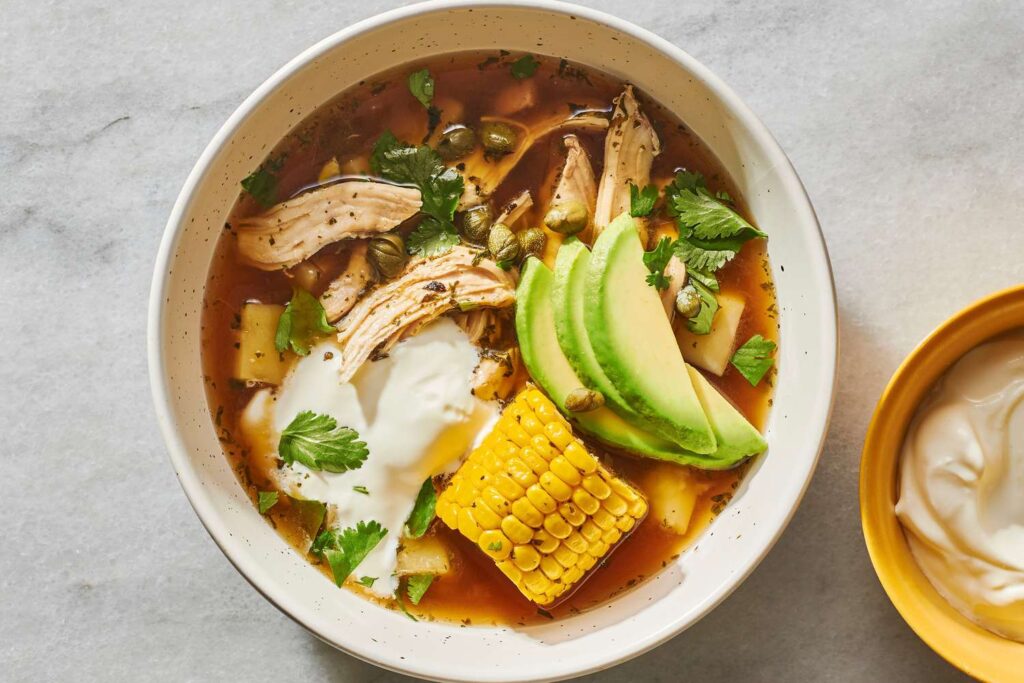
This traditional Colombian chicken and potato soup is not just a dish; it’s a comforting embrace in a bowl, famous in Bogotá and cherished throughout the country. Follow this step-by-step guide to bring a taste of Colombia to your kitchen.
Ingredients:
- 3 chicken breasts (skinless and boneless)
- 2 gallons of water (approx. 7.5 liters)
- 3 types of potatoes:
- 2 pounds of russet potatoes (peeled and chopped)
- 2 pounds of red potatoes (peeled and chopped)
- 2 pounds of Andean potatoes (papa criolla, if available, else substitute with small yellow potatoes, peeled and whole)
- 1 bunch of scallions (chopped)
- 2 cloves of garlic (minced)
- 1 bunch of cilantro (chopped)
- Salt and pepper to taste
- 1 ear of corn (cut into 4 pieces, optional)
- Guasca (a key herb, dried, about ¼ cup)
For serving:
- Avocado (sliced)
- Capers
- Heavy cream
- Cooked white rice (optional)
Instructions:
- Prepare the Broth: In a large pot, combine the chicken breasts, scallions, garlic, half of the cilantro, salt, and pepper with 2 gallons of water. Bring to a boil and then simmer for about 30 minutes, or until the chicken is fully cooked.
- Remove the Chicken: Once the chicken is cooked, remove it from the broth and set aside. When it’s cool enough to handle, shred it into bite-sized pieces.
- Cook the Potatoes: Add the russet and red potatoes to the broth. If you’re using corn, add it at this point as well. Let them cook until they start to fall apart, which will thicken the soup. This process should take about 20-25 minutes.
- Add the Andean Potatoes: If you have papa criolla (Andean potatoes), add them now. These potatoes will give the Ajiaco its distinctive flavor and further thicken the soup. Cook for an additional 10 minutes.
- Return the Chicken to the Pot: Add the shredded chicken back into the pot along with the dried guasca. This herb is essential for giving Ajiaco its unique flavor. Simmer everything together for another 10 minutes, allowing the flavors to meld.
- Final Seasoning: Taste the soup and adjust the seasoning with salt and pepper as needed. Add the remaining cilantro for a fresh burst of flavor.
- Serve: Ladle the Ajiaco into bowls. Serve with slices of avocado, a dollop of heavy cream, capers, and if you like, a side of cooked white rice. Each diner can customize their bowl to their liking.
Tips for Authenticity:
Guasca is key to achieving the authentic flavor of Ajiaco Bogotano. It can be found in Latin American markets or online. The mix of different potatoes is crucial as they each contribute to the texture and flavor of the soup. Ajiaco is traditionally a hearty soup, so don’t worry if it seems thick. It’s meant to be a full meal.
There you have it, a heartwarming bowl of Ajiaco Bogotano, perfect for any day when you need a little Colombian comfort. This dish is more than just a meal; it’s a celebration of Colombian culture and traditions, meant to be shared with loved ones. Enjoy your culinary journey!
Lechona Tolimense Recipe:
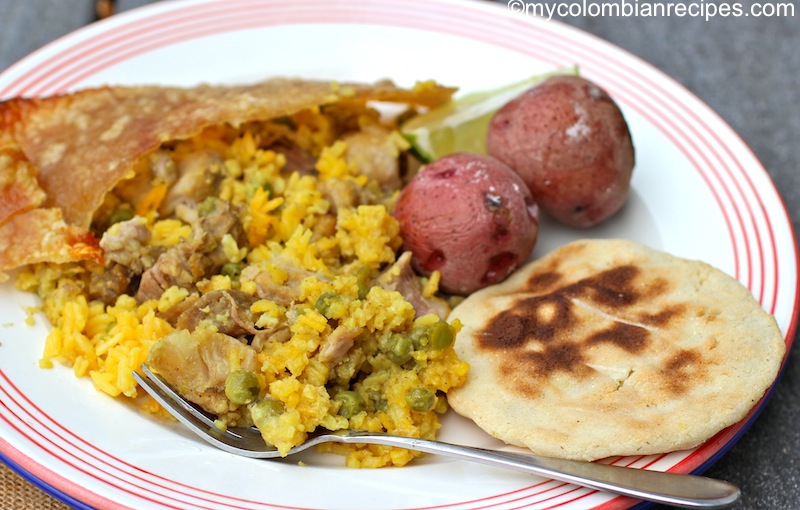
Making Lechona Tolimense is like embarking on a culinary adventure deep into the heart of Colombia’s Tolima region. This dish, a spectacular centerpiece for any celebration, involves slow-roasting a whole pig stuffed with a spiced mixture of rice, peas, and pork. It’s a labor of love, but the end result is nothing short of extraordinary. Here’s how you can bring this traditional feast to your table.
Ingredients:
For the Pig: 1 whole pig (about 20-25 kg or 44-55 lbs, cleaned and prepared for stuffing)
For the Stuffing:
- 2 kg (about 4.4 lbs) of pork meat (finely chopped or ground)
- 2 kg (about 4.4 lbs) of yellow peas (soaked overnight and cooked until tender)
- 3 kg (about 6.6 lbs) of long-grain rice (cooked)
- Green onions (chopped, to taste)
- Garlic (minced, to taste)
- Cumin, salt, and pepper (to taste)
- Saffron or coloring (for color, optional)
Instructions:
- Prepare the Pig: Ensure the pig is fully cleaned, with the hair removed. The pig should be opened up along the belly to allow for stuffing. Pat the inside dry with paper towels.
- Make the Stuffing: In a large mixing bowl, combine the finely chopped or ground pork meat with the cooked yellow peas and cooked rice. Add the chopped green onions, minced garlic, cumin, salt, pepper, and saffron or food coloring for a vibrant color. Mix everything thoroughly to ensure the flavors are well distributed.
- Stuff the Pig: Stuff the mixture into the cavity of the pig. It’s important to pack the stuffing tightly and evenly to ensure it cooks properly and the flavors meld together.
- Sew It Up: Once stuffed, sew the opening of the pig closed with strong kitchen twine. This will prevent the stuffing from falling out during the cooking process.
- Prep for Roasting: Preheat your oven or roasting area (a large, outdoor oven or roasting pit is traditionally used) to a low temperature, around 250°F (120°C). If you’re using an outdoor pit, make sure the coals are hot and evenly distributed.
- Roast: Place the pig on a large roasting rack or in a roasting pan. If using an oven, this will take around 8 to 10 hours, depending on the size of the pig and the consistency of your oven’s temperature. If you’re using an outdoor setup, the time might vary. The goal is a crispy outer skin and a fully cooked, flavorful stuffing.
- Check for Doneness: The lechona is done when the skin is crispy and golden brown, and the internal temperature of the stuffing reaches 165°F (74°C). You can check this with a meat thermometer.
- Serve: Let the lechona rest for about 20 minutes before cutting into it. Serve it by cutting through the crispy skin and spooning out portions of the flavorful stuffing along with pieces of the tender, roasted pork.
Tips for Success:
- Patience is Key: Lechona Tolimense takes time and attention to detail. Don’t rush the process.
- Temperature Control: Maintaining a low and steady heat is crucial for cooking the lechona evenly and achieving that perfect crispy skin.
- Serving: Lechona is best served hot and fresh out of the oven. It’s traditionally accompanied by arepas and a side of ají (Colombian hot sauce).
This feast is a true celebration of Colombian culinary traditions, perfect for special occasions and gatherings. While it requires effort and patience, the result is an unforgettable dining experience that brings people together. Enjoy the process and the delicious outcome!
Tamales Antioqueños Recipe:
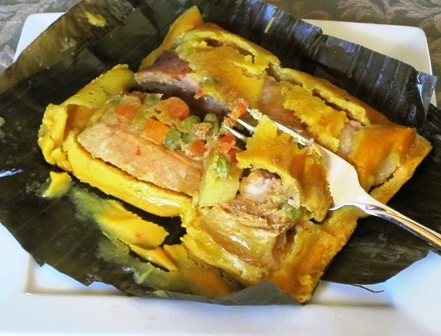
This traditional dish is a staple during the holiday season and a beloved comfort food throughout the year, symbolizing family and celebration. These tamales are a bit different from their Mexican counterparts, as they’re wrapped in banana leaves, which impart a unique flavor. Here’s how to bring this festive dish into your kitchen.
Ingredients:
For the Masa (Dough):
- 4 cups of pre-cooked yellow cornmeal (masarepa)
- 2 cups of chicken broth
- 1 cup of pork lard (or vegetable shortening for a lighter version)
- Salt to taste
For the Filling:
- 1 pound of pork belly, cut into small pieces
- 1 pound of chicken (thighs or breasts), cut into small pieces
- 4 large carrots, peeled and sliced
- 2 cups of cooked peas
- 1 cup of sliced bell peppers (optional)
- Salt, pepper, and spices (like cumin and achiote for color and flavor) to taste
Additionally: Banana leaves for wrapping and string for tying
Instructions:
- Prepare the Masa: In a large mixing bowl, combine the cornmeal, chicken broth, and pork lard. Season with salt and knead until you have a soft, pliable dough. If the mixture seems too dry, add a bit more broth; it should be moist but not sticky.
- Cook the Meats: Season the pork belly and chicken pieces with salt, pepper, and your chosen spices. In a large pan, brown the meats until they’re cooked through. Set aside to cool.
- Prepare the Banana Leaves: Clean the banana leaves with a damp cloth and cut them into squares large enough to wrap the tamales (about 12×12 inches). Briefly pass each leaf over an open flame or hot plate to make them more pliable and easier to fold.
- Assemble the Tamales: mLay a banana leaf square on a flat surface. Place a scoop of masa in the center and flatten it slightly with your hand. Add a piece of pork, a piece of chicken, some carrot slices, peas, and bell peppers (if using) on top of the masa. Fold the banana leaf over the filling, tucking in the sides as you roll, to encase the tamal completely. Secure it with string, making sure it’s tight enough to hold everything together but not so tight that it squeezes the filling out.
- Steam the Tamales: Fill a large steamer pot with water and bring it to a boil. Place the wrapped tamales in the steamer basket, making sure they’re not too crowded. Cover and steam for about 1.5 to 2 hours, or until the masa is firm and pulls away from the leaf easily.
- Serving: Carefully remove the tamales from the steamer and let them rest for a few minutes before unwrapping. Serve hot, allowing guests to unwrap their own tamal, which adds to the experience.
Tips for Success:
- Flavoring the Masa: Feel free to experiment with the masa by adding chicken bouillon, spices, or even a bit of the fat rendered from browning the meats for extra flavor.
- Wrapping: Don’t worry if your first few tamales seem a bit rustic; it takes a little practice to get the hang of wrapping them neatly.
- Serving Suggestion: Tamales Antioqueños are often enjoyed as part of a festive meal or for breakfast with a side of hot chocolate.
Making Tamales Antioqueños is a labor of love, a process often shared with family and friends. It’s more than just a recipe; it’s a celebration of Colombian culture and tradition, bringing warmth and joy to any table. Enjoy the process and the delicious results!
Natilla Colombiana Recipe:

This sweet, custard-like dessert is a staple during Colombian Christmas celebrations, but honestly, it’s so delicious that I wouldn’t blame you for wanting it all year round. It’s creamy, it’s comforting and best of all, it’s surprisingly simple to make. Let’s get straight to whisking up some of this festive treat, shall we?
Ingredients:
- 4 cups of milk (whole milk works best for creaminess)
- 1 cup of sugar (adjust to taste; some like it sweeter, some less so)
- 1 cup of cornstarch
- 1/2 cup of water (to dissolve the cornstarch)
- 2 sticks of cinnamon
- 1/2 teaspoon of ground cinnamon (for garnishing)
- 1 tablespoon of butter
- Grated coconut (optional, but highly recommended for added texture and flavor)
- Cloves (optional, for a spicier note)
Instructions:
- Mix the Cornstarch: In a small bowl, dissolve the cornstarch in the 1/2 cup of water. Make sure there are no lumps. This will be your thickening agent.
- Heat the Milk: In a large pot, combine the milk, sugar, and cinnamon sticks. Cook over medium heat, stirring occasionally to prevent the milk from burning. If you’re using cloves, add them here as well.
- Add the Cornstarch Mixture: Once the milk is warm and the sugar has dissolved, slowly add the cornstarch mixture to the pot, stirring constantly. This is the crucial part to avoid lumps in your natilla.
- Thicken the Natilla: Continue to cook over medium heat, stirring constantly. The mixture will start to thicken. This is where the magic happens! Keep stirring to ensure a smooth consistency.
- Final Touches: When the mixture has thickened to a custard-like consistency (it should coat the back of a spoon nicely), remove it from the heat. Stir in the tablespoon of butter until it’s fully melted and integrated. The butter adds a lovely sheen and richness to the natilla.
- Cool and Serve: Pour the natilla into a serving dish or individual bowls. Allow it to cool at room temperature for a bit before refrigerating. Natilla is traditionally served cold. Sprinkle the ground cinnamon on top for garnish, and if you like, sprinkle some grated coconut over it for an extra layer of flavor and texture.
Tips for Perfect Natilla:
- Constant Stirring: The key to a lump-free natilla is constant, vigilant stirring, especially after adding the cornstarch.
- Flavor Variations: Feel free to experiment with flavors. Some people like to add a splash of vanilla extract or even a bit of liquor (like rum) for an adult version.
- Serving Suggestion: Natilla is often served alongside buñuelos (fried dough balls) during the holidays, making for a perfect sweet and savory combination.
There you have it, a classic Natilla Colombiana recipe that’s sure to please any sweet tooth. Whether you’re making it for a festive occasion or just because, this creamy dessert is a comforting reminder of the simple joys in life. Enjoy making (and eating) it!
Buñuelos Recipe:

These little fried dough balls are like bites of heaven, especially when they’re fresh and hot. In Colombia, they’re a must-have during Christmas, but let’s be honest, they’re too good to save for just once a year. Ready to whip up some of these crispy-on-the-outside, fluffy-on-the-inside delights? Let’s get frying!
Ingredients:
- 2 cups of queso fresco (or a firm, salty cheese, crumbled finely)
- 1 and 1/2 cups of cornstarch
- 1/2 cup of all-purpose flour
- 2 tablespoons of sugar
- 1 teaspoon of baking powder
- 1/2 teaspoon of salt
- 2 eggs
- About 1/4 cup of milk (you might need a bit more or less, depending on the dough)
- Oil for frying (vegetable or canola works best)
Instructions:
- Combine the Dry Ingredients: In a large mixing bowl, whisk together the cornstarch, all-purpose flour, sugar, baking powder, and salt.
- Add the Cheese: Crumble the queso fresco (or your chosen cheese) finely and add it to the dry ingredients. Mix well to ensure the cheese is evenly distributed.
- Mix in the Eggs: Make a well in the center of your dry ingredients and add the eggs. Start mixing, gradually incorporating the dry and wet ingredients until you get a crumbly mixture.
- Add Milk and Form Dough: Slowly add milk, a little at a time, until you have a soft, manageable dough. The dough should be moist but not sticky; it should hold together well enough to be rolled into balls.
- Shape the Buñuelos: With lightly oiled hands (to prevent sticking), take small portions of the dough and roll them into smooth balls, about the size of a golf ball. Aim for uniform size to ensure even cooking.
- Heat the Oil: In a deep fryer or a large, deep pot, heat the oil to 350°F (175°C). You’ll need enough oil so the buñuelos can float freely.
- Fry the Buñuelos: Carefully place a few dough balls into the hot oil. Don’t overcrowd the pot; they need room to expand and float. Fry them until they’re golden brown, turning them occasionally for even cooking. This should take about 4-5 minutes.
- Drain and Serve: Once they’re beautifully golden and crispy, remove the buñuelos from the oil with a slotted spoon and drain them on paper towels. They’re best served warm, when they’re extra delicious.
Tips for Perfect Buñuelos:
- Temperature Control: Keeping the oil at the right temperature is crucial. Too hot, and the outside will burn before the inside cooks; too cool, and they’ll absorb too much oil and become greasy.
- The Test Fry: Before frying the whole batch, test one buñuelo to make sure the oil is at the correct temperature and the dough is perfect. Adjust the dough or oil temperature as needed.
- Serving Suggestion: Buñuelos are fantastic on their own, but they’re also great with a side of natilla for dipping. The combination of the savory cheese flavor with the sweet custard is a holiday tradition.
And there you have it, a simple guide to making Buñuelos that are sure to impress. Whether for a festive occasion or a treat-yourself moment, these little fried dough balls are a joy to make and eat. Enjoy your culinary adventure!
Conclusion
Embracing the festive spirit of a Colombian Christmas through its traditional foods offers a window into the country’s rich cultural and culinary heritage. Whether you’re looking to recreate these dishes at home or simply explore the flavors of Colombia during the holiday season, the recipes and traditions shared her promise a festive celebration that’s both delicious and deeply meaningful.
Disclosure: Our blog contains affiliate links to products. We may receive a commission for purchases made through these links. However, this does not impact our reviews and comparisons. We try our best to keep things fair and balanced, in order to help you make the best choice for you.


